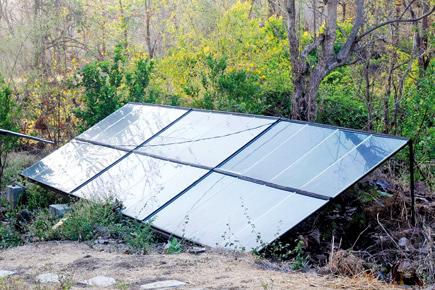A century back, on January 9, Mahatma Gandhi made his determined journey to India with a singular goal to Make in India. He wanted to make in India a movement of freedom from foreign oppression, discrimination, and social apartheid

Solar power panels
A century back, on January 9, Mahatma Gandhi made his determined journey to India with a singular goal to Make in India. He wanted to make in India a movement of freedom from foreign oppression, discrimination,and social apartheid. The capital needed for this was in the form of bold assets of non-violence and civil disobedience.
ADVERTISEMENT

Solar power panels (above) can provide electricity for self-use, with the surplus being sold to the grid for commercial purposes. File photo
Speaking on Independence Day August 15, 2014 from the ramparts of New Delhi’s historic Red Fort, Prime Minister Narendra Modi launched his equally historic and rousing Make in India campaign. His venture capital in launching this movement is in the form of India’s unique demographic dividend — the youth that constitute 65 per cent of its population.
The last time India arrived on the world scene with its technological supremacy was in late 1990s when software engineering crews of India created their back-office hives to help digitally managed businesses of the West. Those hives and their verticals and scale-ups are now over-dripping into the national treasury a stream of honey of $125 billion, of which exports are nearing $100 billion.
The role of the Indian diaspora in India’s transformation into a digital world had been crucial. Their vast networks with corporate houses, their elite image, well groomed expertise and their financial muscle-power helped Indian companies make inroads in the US and in European markets.
Once again India has a unique opportunity for yet another transformation. We can remind the world of our belief in nature-power to address the defining challenge of this century — climate change. By turning Make in India into Make in India with Green Power, we can create a win-win situation. The role of the diaspora in moving forward by using renewable energy will again be crucial. For more than five years renewable energy has been part of an amazing story all over the world.
It is the only energy sector where investment and installed capacity have consistently grown with surprisingly steep rates. Going by its report, the World Energy Outlook 2014, renewable sources should in 2040 dethrone coal as a primary source of electricity.
Communities of residents, farmers, self-help groups, SMEs and corporate houses can come together to build solar PV electricity generation plants on rooftops of every building, on the arid land around villages, unused land of farmers, on the long routes of irrigation water canals (as is done in Gujarat), on railway and bus stations, on factory shades, corporate houses, government buildings and even parking places. These micro-power plants could then be ‘wired’ to develop the community grids — an energy internet — that would provide electricity for self-use, with the surplus being sold to the grid for commercial purposes.
Deploying an affordable storage technology to enable the stocking of electricity can resolve the problem related to cloudy days when solar energy is inadequate and quiet days when wind energy is not generated. Such storages could be based on the present technology of using nano-technologies or storing hydrogen produced by water electrolysis using solar energy. When millions of buildings are generating small amounts of electricity locally, on-site, they can sell the surplus to the grid and share electricity with their neighboring communities.
Many of the 25 million Indian diaspora, spread over 180 countries have the potential to contribute to the campaign by providing their expertise. Venture capitalists like Vinod Khosla and Kanwar Rekhi could promote manufacture of efficient solar cells and storage technology; software honchos like Satya Nadella and Sabeer Bhatia could develop the energy-internet and finance experts like Vikram Pandit could provide a financial road map. India has chance to be the first country to use the diaspora’s potential to fight the global war against climate change through the energy-Internet.
Rajendra Shende, an IIT alumnus, is chairman of the TERRE Policy Centre and a former director of the UNEP.
The views expressed in this column are the individual’s and don’t represent those of the paper.
 Subscribe today by clicking the link and stay updated with the latest news!" Click here!
Subscribe today by clicking the link and stay updated with the latest news!" Click here!







